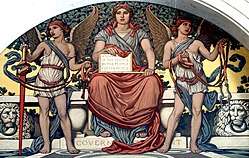Bank reserves
| Public finance |
|---|
 |
|
Reform |
Bank reserves are a commercial banks' holdings of deposits in accounts with a central bank (for instance the European Central Bank or the applicable branch bank of the Federal Reserve System, in the latter case including federal funds), plus currency that is physically held in the bank's vault ("vault cash").[1] Some central banks set minimum reserve requirements, which require banks to hold deposits at the central bank equivalent to at least a specified percentage of their liabilities such as customer deposits. Even when there are no reserve requirements, banks often opt to hold some reserves—called desired reserves—against unexpected events such as unusually large net withdrawals by customers or bank runs.
In relation to bookkeeping, the term is a misnomer. Reserves are ordinarily part of the equity of the company and are therefore liabilities. Bank reserves, on the other hand, are part of the bank's assets. In a bank's annual report, bank reserves are referred to as "cash and balances at central banks".
Terms
- Reserves on deposit (of a commercial bank): the deposit accounts for the commercial bank at the central bank.[2]
- Vault cash (of a commercial bank): paper currency and current coins owned by the commercial bank and (generally) held in the bank vaults of the commercial bank.[3]
- Borrowed reserves: bank reserves that were obtained by borrowing from the central bank.
- Non-borrowed reserves: bank reserves that were not obtained by borrowing from the central bank.
- Required reserves: the amount of reserves (reserves on deposit plus vault cash) that commercial banks are required to hold, as determined by the central bank as a function of the commercial bank's deposit liabilities.[4]
- Excess reserves: bank reserves in excess of the reserve requirement. A portion of excess reserves (or even all of them) may be desired reserves.
- Free reserves: the amount by which excess reserves exceed borrowed reserves.[5]
- Total reserves: all bank reserves, i.e. cash in the vault, plus reserves on deposit at the central bank, also borrowed plus non-borrowed, also required plus excess.
Notes
- ↑ In the case of the Federal Reserve System in the United States, see, e.g., Regulation D, at 12 C.F.R. sec. 204.5(a) and 12 C.F.R. sec. 204.2(k).
- ↑ See, e.g., U.S. Federal Reserve System regulation at 12 C.F.R. section 204.5(a)(1)(i).
- ↑ See, e.g., U.S. Federal Reserve System regulations at 12 C.F.R. section 204.5(a)(1) and 12 C.F.R. section 204.2.
- ↑ See, e.g., U.S. Federal Reserve System regulation at 12 C.F.R. section 204.4.
- ↑ Vogel 2001:421.
See also
References
Vogel, Harold L. (2001). Entertainment Industry Economics: A Guide for Financial Analysis. New York: Cambridge University Press. ISBN 0-521-79264-9